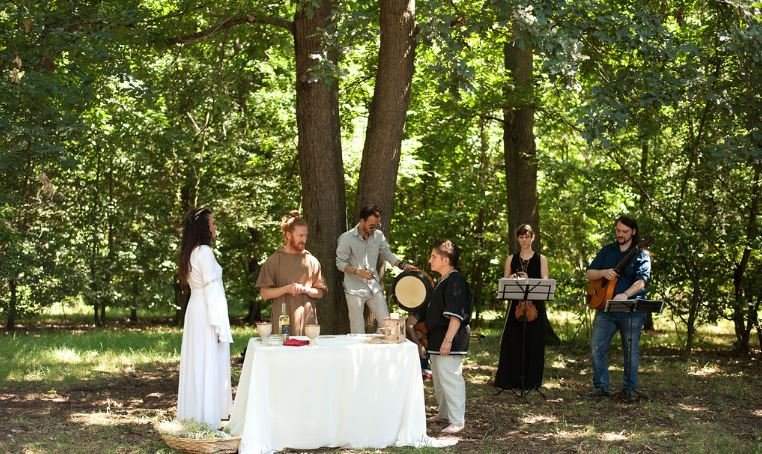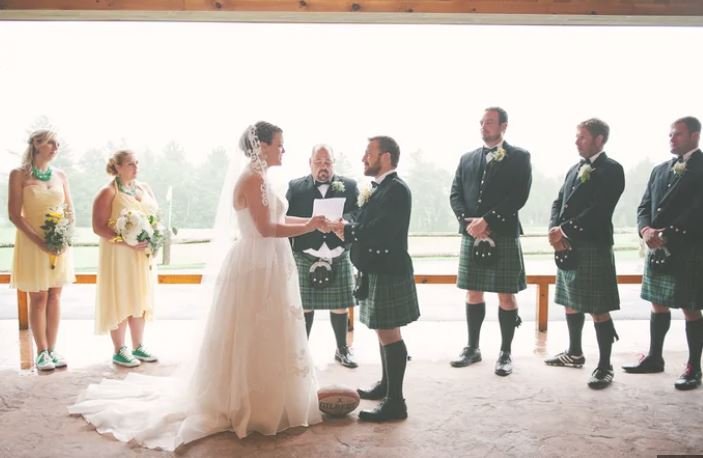Celtic wedding rituals provide couples with a meaningful way to honor their heritage and symbolize their union. These ancient traditions, deeply rooted in Celtic culture, add a unique and spiritual dimension to any wedding ceremony. Incorporating these rituals into your wedding creates a truly memorable experience. Here, I’ll explore some of the most significant Celtic wedding rituals and their meanings.

Handfasting: The Ancient Knot of Love
Handfasting is one of the most well-known Irish wedding rituals and inspired the phrase “tying the knot.” This ancient ritual involves binding the couple’s hands together with a cord, ribbon, or braided fabric, symbolizing their union. Historically, Celtic cultures used handfasting as a form of betrothal, representing the couple’s intention to be together for a year and a day before officially marrying.
In modern weddings, couples often incorporate handfasting into the ceremony as a symbol of commitment. The cord wraps around their hands while they exchange vows, signifying their bond. Choosing cord colors that represent different aspects of their relationship, such as love (red), fidelity (blue), or prosperity (green), personalizes the ritual. Handfasting beautifully fits any wedding, regardless of religious or cultural background, as it emphasizes the personal connection between the couple.
The Oathing Stone: Vows Set in Stone
The Oathing Stone is another ancient Celtic tradition that involves the couple holding or placing their hands on a stone while they say their vows. Celtic belief holds that stones connect to the earth and nature, symbolizing strength and permanence. Swearing vows on the stone calls upon the natural world to witness and bless the union.
Couples personalize the Oathing Stone ritual by selecting a stone with special meaning, such as one from a place they’ve visited together. After the ceremony, they keep the stone as a lasting reminder of their vows. The Oathing Stone ritual perfectly complements outdoor weddings, where the connection to nature plays an integral part in the celebration.
Celtic Knot: The Eternal Bond
Celtic knots feature intricate, interwoven patterns with no beginning or end, symbolizing eternity, unity, and interconnectedness. In Celtic wedding traditions, the knot represents the everlasting bond between two people. The endless loops remind couples and their guests that love and life are continuous and intertwined.
Couples incorporate Celtic knot designs into various aspects of their wedding, from the design of their wedding rings to invitations, ceremony decor, or even embroidered attire. The knot adds symbolism, reminding everyone of the enduring nature of the couple’s union.
The Quaich: Sharing Life’s Journey
The Quaich, also known as the “Cup of Friendship,” serves as a two-handled drinking vessel used in Celtic wedding ceremonies to symbolize sharing life’s journey. In this tradition, the couple drinks from the same cup, usually filled with whiskey, wine, or another symbolic beverage. Sharing the drink represents trust, unity, and a willingness to share everything in married life.
Couples incorporate the Quaich ceremony by choosing a drink with personal significance and taking turns drinking from the cup. The Quaich itself often becomes a cherished keepsake, passed down through generations as a symbol of love and unity.
The Claddagh Ring: Symbol of Love, Loyalty, and Friendship
The Claddagh ring, featuring a heart (representing love), a crown (symbolizing loyalty), and two hands (signifying friendship), originates from the village of Claddagh in Ireland. Couples often give this ring as a token of love, wearing it as an engagement or wedding ring.
Couples wear the Claddagh ring in various ways to symbolize their relationship status. Wearing it on the right hand with the heart facing outward indicates that the wearer is single, while turning the heart inward signals a relationship. On the left hand, with the heart facing inward, the ring symbolizes marriage.
Conclusion
Celtic wedding rituals offer couples a rich tapestry of symbolism, connecting them to ancient traditions and the natural world. Handfasting, the Oathing Stone, and the sharing of a Quaich provide meaningful ways to celebrate love and unity. Incorporating these timeless customs into your wedding ceremony creates a celebration that is both beautiful and deeply rooted in history and culture.

